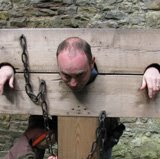To follow up my recent posts on the 21st century museum and the National Collections Online feasibility study, here's a little more about the question of how funds are allocated by bodies like HLF, and how come we've tended to see them requiring digitisation projects to run from end to end, from digitisation to web publication.
I don't really know enough about the programmes that were run in the past like, for example, NOF Digitise and the HLF (still funding today). However from the projects that I do know that drew on these funding streams, it seems clear enough that concentrating on digitisation per se was never enough - a user-facing product was expected. These did have a sort of aggregated interface (http://www.enrichuk.net/, now pointing at MICHAEL UK) but not really what I've got in mind.
It's quite understandable that this practice persists, indeed there is a good case for it. For funders, they want to see direct user impacts, and a website that can generate stats is nice for that. For museums, well they have a two-fold role - to hold and to document their collections; and to research and interpret them for various audiences. Naturally, then, there will be forces within them urging them to do something with the stuff they digitise, and do it now. The downside is that this has led to fragmentation of the materials digitised for these programmes.
My argument is that for modest sized projects it's not good to spread yourself too thinly trying to do everything, but instead to concentrate on part of the value chain. It's a straighforward architectural thing, and essentially I've realised that I'm just asking for a shift in the assumptions of funding bodies from demanding vertical slices to demanding (contributions to) horizontal slices - in short, to encourage the building of a strong sector-wide layered architecture. Vertical businesses deal in multiple (if not all) links in the chain from production to consumption. This is not really suited to much of what we do. Indeed even behemoths like Amazon don't yet do this (though they a strategically building out from their core business) - they don't actually write books or commission, edit and publish them, print them, or market them, or at the other end deliver them. They flog 'em and dispatch them, and act as an agent for others to do the same.
It's crazy to ask, as a precondition for funding, that a museum or partnership does the whole chain from digitisation and record enhancement, to search engine development, perhaps aggregating records, through to building the user experience as a website, a game etc. Things get done again and again and again, effects are diluted, money wasted. Lots of good stuff will still be made, of course. I don't know what this horizontal architecture would be like, though just possibly we can see parts of it falling into place with PNDS and the Integrated Architecture, and I don't know to what degree it would play a part in many projects in which UK museums engage, but I'm just suggesting that instead of HLF, for one, getting hung up on projects doing the whole end-to-end thing they should support us in coming up with a model to slice the market differently, working on one step at a time, and recognising that the very process of creating the digitised content is a valuable step that is somewhat independent of the creation of an audience-facing instance of it. Vertical slices make silos.
For more on slicing and dicing see here. Shalom.

2 comments:
Thanks for this further insight. It is exactly what I've been thinking but articulated with a good nice diagrammatic shape, and comparing it to commercial approaches is useful.
Thank you Bridget, I'm glad you found it interesting. I know we're on the same page with this stuff. And I hope I didn't come over as too negative in my other post about the NCO forum. I think you and Mark are doing a great job to focus that project and I'm hoping I can make it to the next gathering.
Post a Comment